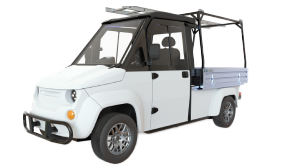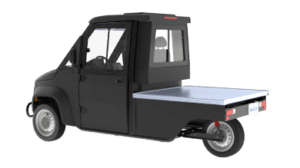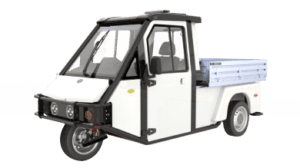MAX-EV Does Heavy Lifting at Port of Hamilton
(Original article published by Driving.ca, see link here)
“ We are dealing with steel-industry stevedores, so we thought there might be some resistance when you compare using smaller electric utility vehicles to a Ford F-250 pickup truck, but the feedback has been positive,” says Lacombe.
In beautiful Hamilton Harbor in southwest Ontario, the Federal Marine Terminal (FMT) services the busiest port on the Canadian side of the Great Lakes. Besides windmill components and bulk commodities such as South American sugar, shipments of hard-rolled steel comprise 80 percent of the daily arrivals. Massive coils and slabs weighing 25 tonnes each get finished in the Hamilton steel mills before being shipped to auto-parts factories around the province.
Mobility in and around the terminal’s 300,000-square-foot warehouse and outdoor cargo storage spaces is essential for a variety of workers and their tools. Crane operators, forklift operators, longshoremen and stevedores all must shuttle between different job sites, while supervisors are deployed for safety audits, and the head checker must be on hand to match each piece of arriving cargo against the manifest.
The Federal Marine Terminal searched for eco-friendly options to traverse the giant facility. “We determined most trips in the warehouse are about 2.3 kilometers,” says Mathieu Lacombe, reliability engineer for FMT. “We were looking for a reliable, efficient way to deploy people and tools quickly. We used golf carts in the past, but decided golf carts just weren’t right for the operation.” Research revealed that golf carts frequently came up short for the durability and size needed, while the size and expense to operate pickup trucks wasted resources.
As Lacombe and his team began researching electric utility vehicles, their biggest challenge was finding a Canadian manufacturer. “Federal grants for electrification of operations are sometimes tied to in-country manufacturers,” Lacombe says.
Their search finally led them to purchase a small fleet of tough MAX-EV mini-electric utility vehicles from Westward Vehicles in Winnipeg. This was the ideal way, Lacombe says, to test an EV solution. “Whatever we do, it has to be a step in the right direction.”
In the summer of 2022, Westward Vehicles delivered six MAX-EVs to the Federal Marine Terminal, posing for a quick photo op next to the enormous bulk carrier, MV Federal Clyde, before getting right to work.

Low Speed Vehicle Fleet
Throughout FMT’s shipping season, the MAX-EVs are in constant motion, something the small trucks are built for. While FMT estimated the MAX-EVs’ batteries would need charging every two days, they’ve worked every shift while being charged just once a week!
So, how did the MAX-EV workhorse compete on price? Continuing with golf carts would have seen a much lower initial investment, but FMT wisely performed a total cost of ownership (TCO) analysis and realized that the electric UTVs would be cheaper after about four years, thanks to the cost of electrons over fossil fuel.
The price range for the MAX-EV runs between $20,000 and $40,000 depending on optional equipment, an investment that FMT considers a reasonable “stepping stone” as it transitions part of its business from fuel to electricity, reducing carbon emissions and costs while increasing durability and reliability.
“They’re even street-legal,” Lacombe says with a bit of pride. Though capable of speeds up to 40 km/h, the MAX-EV is limited to 25 km/h for safe transit around the docks and near massive cranes. “There are just too many moving parts in the terminal,” he said, while noting that less moving parts in the vehicles themselves means less maintenance downtime.
FMT has forecast a 15- to 25-megatonne CO2-emissions reduction and approximately $20,000 savings in fuel and maintenance costs by using the six MAX-EVs. But a surprising measure of success has come from worker feedback.
“We are dealing with steel-industry stevedores, so we thought there might be some resistance when you compare using smaller electric utility vehicles to a Ford F-250 pickup truck, but the feedback has been positive,” says Lacombe.
By embracing a change to electric vehicles, FMT has set an example of sustainability that others in their industry would be wise to follow. But the decision by FMT to purchase EVs and UTVs from Westward Vehicles isn’t just about the environment. It’s about the best vehicle for the job. It’s about functionality, cost-savings and a commitment to seeking better solutions for their business. The fact is, advances in these products can now provide a cost-effective and sustainable competitive advantage for businesses.
With four models and several a la carte options available—including a two-passenger version with cargo bed or a four-passenger version—it’s easy to see why the MAX-EV is the best option for those needing robust low-speed vehicles. Our experienced team of engineers and EV specialists, Westward Vehicles continues to innovate in the world of EVs. We look forward to partnering with more organizations like FMT on their journey towards mobility transformation—Westward Vehicles is the future For EVs and UTVs. Contact us today to start saving.































